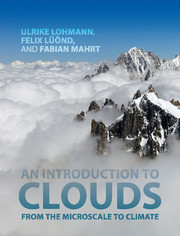Book contents
- Frontmatter
- Dedication
- Contents
- Preface
- List of symbols and acronyms
- 1 Clouds
- 2 Thermodynamics
- 3 Atmospheric dynamics
- 4 Mixing and convection
- 5 Atmospheric aerosol particles
- 6 Cloud droplet formation and Köhler theory
- 7 Microphysical processes in warm clouds
- 8 Microphysical processes in cold clouds
- 9 Precipitation
- 10 Storms and cloud dynamics
- 11 Global energy budget
- 12 Impact of aerosol particles and clouds on climate
- References
- Index
9 - Precipitation
Published online by Cambridge University Press: 05 June 2016
- Frontmatter
- Dedication
- Contents
- Preface
- List of symbols and acronyms
- 1 Clouds
- 2 Thermodynamics
- 3 Atmospheric dynamics
- 4 Mixing and convection
- 5 Atmospheric aerosol particles
- 6 Cloud droplet formation and Köhler theory
- 7 Microphysical processes in warm clouds
- 8 Microphysical processes in cold clouds
- 9 Precipitation
- 10 Storms and cloud dynamics
- 11 Global energy budget
- 12 Impact of aerosol particles and clouds on climate
- References
- Index
Summary
In the previous three chapters we discussed on the microscale how cloud droplets and ice crystals form and how they can grow and reach precipitation size. In this chapter we take a more macroscopic perspective and start with an overview of observed precipitation rates (Section 9.1). Raindrop and snowflake size distributions have been observed to be exponential, as discussed in Section 9.2. At Earth's surface, rainfall and snowfall rates are measured with rain gauges. In the atmosphere they are estimated from radar reflectivity. In fact, radars are irreplaceable for the short-term forecast, called “nowcast”, of precipitation events. We discuss how estimates of precipitation rates can be obtained from radar measurements and how radar images can be interpreted (Section 9.3). Next we discuss how precipitation can be classified into stratiform and convective precipitation (Section 9.4) and explain its mesoscale structure (Section 9.5). This chapter concludes with a discussion of the geographical distribution of precipitation in the present climate, how it has changed since the 1950s and how it is projected to change until the end of this century (Section 9.6).
Precipitation rates
As discussed in Chapter 7, precipitation in warm clouds involving only the liquid phase forms via collision–coalescence. Collision–coalescence is favored in clouds which have a large liquid water content with relatively few cloud droplets. Therefore clouds which form precipitation involving only the liquid phase are mainly convective clouds over the tropical oceans. However, even in the tropics only 31% of the total precipitation is “warm rain” (Lau and Wu, 2003). Warm-phase precipitation often produces light precipitation (drizzle) because it is less efficient than precipitation formation involving the ice phase. An exception are tropical islands such as Hawaii, where significant warm rain has been observed due to orographic forcing.
After hydrometeors are formed, they can continue to grow by collisions with other hydrometeors such as cloud droplets (Section 7.2) or ice crystals (Section 8.3) as illustrated in Figures 8.18 and 8.19. All collision processes that involve hydrometeors of either different sizes or different phases are summarized as growth by accretion (Section 8.3.3). Depending on the phases of the hydrometeors involved, accretion leads to raindrops, snowflakes, graupel or hailstones. Regardless of how precipitation is initiated inside clouds, over a large part of Earth's surface it reaches the ground as rain because the average surface temperature of Earth is +15°C.
- Type
- Chapter
- Information
- An Introduction to CloudsFrom the Microscale to Climate, pp. 251 - 284Publisher: Cambridge University PressPrint publication year: 2016



